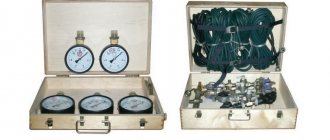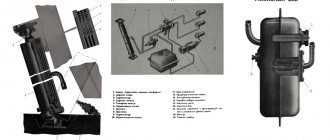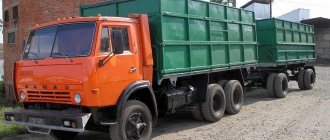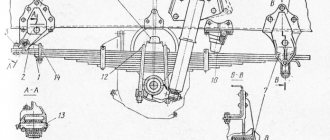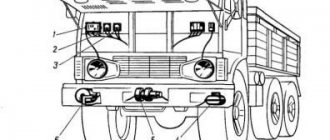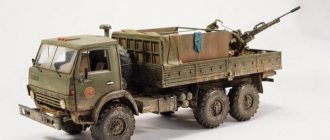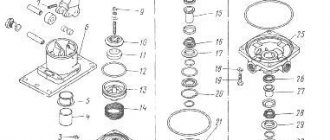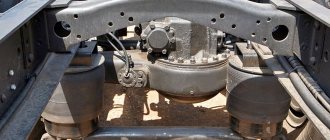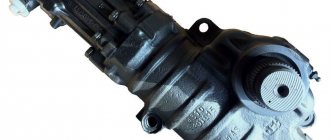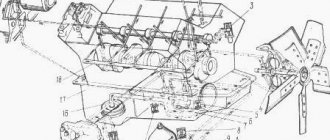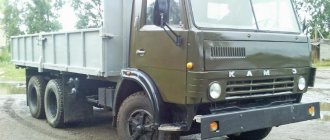Any component or mechanism of a car, be it an engine, transmission, compressor system or just a KamAZ PGU, has its own characteristics, a certain operating principle, advantages and disadvantages. Typically, detailed information is needed by those whose professional activities require it. Why you personally might need a description of the two-cylinder compressor 5320-3509015 for KamAZ vehicles, we will not even try to guess, but we will present the description itself at your disposal.
According to the type of action, this device belongs to piston indirect single-stage compression compressors. The standard installation diagram is on the back cover of the unit, or more precisely on its front end. It is driven by a gear drive from a block of distribution gears. The KamAZ two-cylinder compressor is equipped with aluminum pistons with floating pins. To eliminate the possibility of axial movement of the pins, retaining rings are used to secure the pins in the piston bosses.
To provide air access to the compressor cylinders from the engine intake manifold, plate-type intake valves are used. The air compressed by the pistons is forced into the pneumatic system through the same lamellar, but already discharge valves, which are located in the cylinder head.
The block and head are cooled using liquid supplied from the main engine cooling system. Structurally, the KamAZ two-cylinder compressor is designed for automatic lubrication of rubbing surfaces. Lubrication oil is supplied from the engine line - first to the rear end of the compressor crankshaft, and then through the seal through channels to the connecting rod bearings. Main ball bearings, cylinder walls and piston pins are lubricated by splash lubrication.
Consultation on technical issues, purchase of spare parts 8-916-161-01-97 Sergey Nikolaevich
The KamAZ compressor is a source of compressed air in the pneumatic drive of the brake system of trucks produced by the Kama Automobile Plant. The main purpose of the mechanism is to increase the supply of the fuel-air mixture. The use of a mechanical supercharger allows you to increase the performance of the combustion chamber and increase the power of the power plant without increasing the capacitance indicators.
Design and principle of operation
KamAZ vehicles are equipped with single- and two-cylinder piston-type units, rarely - membrane type
The compressor device is presented as follows:
- connecting rod
- Piston
- Cylinder with spacer
- Rings: sealing; oil scraper; compression
- Plain bearings
- Carter
- Crankshaft
- Drive gear.
The single-stage compression mechanism is located on the front of the engine flywheel housing. The piston is made of aluminum and has a floating pin secured by thrust rings. Atmospheric air enters the cylinder from the intake manifold of the power plant, which is forced out into the pneumatic system through the discharge valve in the cylinder head.
The liquid is supplied from the engine cooling system and reduces the heating of the cylinder head. Oil flows through the pipelines to the rubbing parts, which lubricates the rear end of the compressor crankshaft and the connecting rod-piston group by splashing.
As soon as the pressure of the pneumatic system reaches 0.8-2 MPa, the pressure regulator is activated and stops the air supply. When the indicator drops to 50 kPa, it closes the outlet, and the compressor pumps air into the system again.
The design and principle of operation are similar to autocompressors for passenger cars, with the only difference being that KamAZ trucks have double protection against short circuits and overheating.
What is a MAZ compressor?
The MAZ compressor is a component of the brake system of trucks of the Minsk Automobile Plant with pneumatic drive mechanisms; a machine for compressing air coming from the atmosphere and supplying it to the units of the pneumatic system.
The compressor is one of the main components of the pneumatic system; it has three main functions:
• Air intake from the atmosphere; • Air compression to the required pressure (0.6-1.2 MPa depending on the operating mode); • Supplying the required volume of air into the system.
The compressor is installed at the entrance to the system, providing it with compressed air in a volume sufficient for the normal functioning of all components of the brake system and other consumers. Incorrect operation or failure of this unit reduces the effectiveness of the brakes and impairs vehicle controllability. Therefore, a faulty compressor must be repaired or replaced as soon as possible, and in order to make the right choice of unit, you need to understand its types, features and characteristics.
Malfunctions
During operation, it is necessary to monitor the technical condition of the mechanism, lubrication and the flow of coolant. It is recommended to use only the oil that is specified in the power plant data sheet. Lubrication with contaminated oil is prohibited.
The compressor does not require daily or special technical inspections, but the drive and fastening reliability are checked periodically once every 8-10 thousand km.
During operation, breakdowns of unit parts may occur; they are repaired immediately. Those that are faulty must be replaced.
The main malfunctions of a truck compressor are divided into 2 types: piston group; electrical equipment.
The most common defects are:
- Wear of the piston group and violation of valve tightness. The duration of filling the pneumatic system at a crankshaft rotation speed of 2200 rpm exceeds the time established by the technical specifications (8 minutes). The compressor does not pump up a pressure of 7-7.5 kgf/cm². Piston wear causes oil mist to be drawn from the compressor crankcase into the cylinders.
- The system supercharger does not start. Associated with a lack of voltage in the network, a leaking check valve and improper starting.
- The compressor pumps poorly and does not gain speed. One of the reasons is clogged filters.
- Knocks in the cylinder-piston mechanism. Associated with breakdowns in the discharge part as a result of friction and wear of metal parts.
- The engine hums and does not rotate. This problem is possible due to the operation of the mains power fuse, overload protection, poor contact
- Strong heating of the cylinder. Airflow to the cylinder and crankcase is blocked.
- Performance decreases - the suction air filter is clogged.
- Increased vibration
Weak spots
Every car cooling system has some weak points. The most common problems in KAMAZ include:
- occurrence of leaks;
- increase in antifreeze temperature to unacceptable levels;
- supercooling of the coolant;
- penetration of antifreeze into the oil system.
Antifreeze leaks in KAMAZ most often occur at the junction of the pipes. Sometimes this problem occurs due to cracking of rubber hoses. System overheating occurs when the antifreeze level drops sharply. In this case, it is not able to ensure efficient operation of the engine.
Overheating or excessive cooling of the liquid can occur when thermostats fail. It all depends on the position of the valve, which gets stuck, which causes problems. When the thermostat is open, antifreeze is constantly circulating. This prevents the engine from heating up and starting (this is especially noticeable when the blinds are open). When the thermostat is closed, antifreeze does not flow to the radiator, where it cools. Therefore, the coolant in KAMAZ quickly overheats.
Another weak point is the fan and clutch. If it doesn't work efficiently, the engine won't be able to cool enough. Therefore, to prevent problems from occurring, it is necessary to constantly monitor the condition of KAMAZ and promptly eliminate all problems.
How to remove and disassemble
In order to replace failed elements, it is necessary to remove and disassemble the compressor:
- Raise the cab, the unit is located underneath it.
- Unscrew the fastening nuts, remove the head together with the discharge valves, gasket, and springs of the inlet elements.
- Unscrew the 3 tubes using the appropriate wrench
- Unscrew the drive gears and lift the unit towards the front of the vehicle.
Main structural details
The KAMAZ 740 cooling system works reliably and is distinguished by its functionality. It has a classic design. If it fails, the vehicle will not be able to operate normally.
The standard cooling system includes the following elements:
- water pump;
- radiator;
- thermostats;
- cooling Fan;
- pipes
In KAMAZ it is equipped with two thermostats (in passenger cars - only one). This need is associated with the structural features of the engine. It has two pieces of cylinder heads, which are located at right angles. Another distinctive feature of the engine is the presence of cooling louvres on the radiator. This design element allows you to warm up the engine faster at low ambient temperatures.
Do-it-yourself repair of one- and two-cylinder KamAZ compressors
Many equipment owners perform simple routine repairs of a KamAZ compressor with their own hands. The repair work includes several stages, which are as follows:
- Cleaning parts. The burnt oily liquid inside the cover is removed by sandblasting, the element is polished, and the coolant is removed. Then wipe and polish the working surface of the valve plate
- Boring and honing of the cylinder. When working, take into account the parameters of the thermal gap. If the inner side of the cylinder is worn more than 0.02 mm, an expansion is made for repair boring. In some versions, sleeves are installed.
- Replacing the crankshaft connecting rod bearings and bushings with ones that are suitable in terms of characteristics and parameters
- Replacement of pistons equipped with pins and connecting rod rings. During repairs, special attention is paid to the parameters of the cylinder.
- Replacement and repair of gaskets, intake and exhaust valves, seals. The latter must be covered with fasteners.
The equipment is installed on a special stand and tested for performance. When checking, the technician compares the results obtained with the factory parameters of the compressor.
If overheating of the bearings is detected, extraneous knocking of pistons and valves is heard, or the compressor is running oil, the permissible rate of leaking liquid exceeds the required levels, repair work is resumed, but it is better to go to a service station
other news on the topic
Temple based on KamAZ
The first time people started talking about mobile airborne Orthodox churches for the armed forces of the Russian Federation was in early 2012. Representatives of the Russian Orthodox Church.
Design competition from KamAZ
The other day, the jury summed up the results of the KAMAZ-MASTER 3D design competition, during which participants were asked to create an exact copy in a 3D editor.
The concept of KAMAZ OF THE FUTURE has been developed!
In 2013, one specialized web source on automotive design, as well as a designer-artist from the Porsche studio named Marek Simko.
KAMAZ strategy
Plans for the next ten years in domestic production are already known. Already in 2020, KAMAZ OJSC plans to produce 100,000 vehicles from the assembly line. .
The Bravis bus is now available in Chelyabinsk
The Bravis bus, which runs on gas, runs along the highways of the city of Chelyabinsk. The transport is being operated in test mode. Bus - .
How to install
After replacing parts, the compressor must be installed back. To do this you should:
- Place the connecting rod in a vice, press in the bushing and pin, lubricating it with oil
- Place the rings, remove the part from the vice
- Attach head, seat gaskets, valves, springs
- Screw in the plugs
- Press in the crankshaft with oil seals, install thrust rings
- Install the gear and lock washer
- Pull the cover with gasket onto the crankcase, secure with bolts
- Blow with compressed air
- Press intake valves and guides into the cylinder block
- Install the unit head on the block, tighten with nuts
Conclusion
When assembling a compressor from Zilovsky with your own hands, you should remember that this work will require the performer to be able to handle various tools and adhere to the technique of processing all kinds of parts. It is also worth remembering that the purchase of certain units will lead to costs, which means that before starting work, you should carefully evaluate all the costs and compare them with your capabilities. The fact is that with intensive use, such a compressor only lasts for a couple of years.
Homemade cars, tractors, all-terrain vehicles and ATVs
A compressor made from a compressor from ZIL: photo and description of a homemade product.
Hi all! So I decided to make myself a compressor for my home workshop. Spare parts were already available: a ZIL-130 compressor, an 80-liter automobile gas cylinder), an electric motor, a magnetic starter, wheels, an emergency pressure valve from ZIL, etc.
Additionally, I bought a pressure switch (in the end it’s a water switch, but initially I bought a compressor with a button (it’s more expensive), and a reducer unit for air distribution, as well as fittings, wires, and a plug.
The manufacturing process is shown in the photo.
I made a receiver from a cylinder.
The pressure was set to turn off at 7 atm and turn on at 4 atm.
The compressor was slightly modified, the connecting rods and bearings were drilled on three sides. The compressor itself was installed through a gasket on a steel base, and that tube with a cap, the one that comes off from the bottom side, was originally planned for monitoring and filling oil, but in the process we also had to make a tank (breather). My opinion is that if it weren’t for most of the spare parts that I already had in stock, then I don’t think it’s worth bothering with at all, you can buy a ready-made one.
We also recommend reading an article on the topic - how to make a compressor from a refrigerator.
You can effectively and quickly clean any part or structure surface for further repair or use using sandblasting. But this device requires a source of compressed air with the necessary pressure and performance. A self-made compressor for sandblasting will save you from purchasing expensive and not always sufficiently reliable equipment.
Recommendations
Comments 84
I also try to keep the engine clean, but it doesn’t always work)
The engine is beautiful when washed. What did you use to wash the outside? I had a lot of discussions about washing with mechanics (real educated masters, not internet ones :)))). The bottom line is this: if you change the type of oil (that is, semi-synthetic, you want to pour synthetic, or you poured mineral water, but you want to fill semi-synthetic), then it makes sense to rinse it. And then, they say that it is better to simply fill in the oil you want to use and replace it earlier, say after 2500 km. Those. Do not pour the rinsing agent at all. And then change them in the same order. The motivation is that the seals and surfaces have been ground in a certain environment with a certain acidity, then you pour a completely different composition (flushing), this composition reacts with deposits and washes them off from the working surfaces, from the seals, etc. Somewhere the gaps will increase by microns, somewhere the seals may lose elasticity. And when you simply drained one oil and filled in another, then such a sharp change in the pH of the environment does not occur and the engine runs on new oil with remnants (there is still a little left) of the old one. Everything happens more smoothly there. Moreover, current oils have additives that also “wash” the engine while it is running - wash away carbon deposits, etc. I apologize for being boring.
What kind of tediousness?! Everyone’s opinion is interesting, especially if it’s well-reasoned! That’s why we’re writing here! about flushing, I already realized that you shouldn’t pour it... but here’s what to do. I poured mineral water - I want to switch to semi-synthetics... I heard that it can start to foam... if one thing mixes with the other?! And the engine. First, I spray the layman 2000 on top with ordinary foam from a Karcher...let it sit for a little while and beat it off! when I lift the cabin somewhere. men ask: “Why did you install a new engine?! It’s so nice)))))
I had a lot of conversations about Kamaz this year. The main interlocutor was the head of a unit servicing equipment, who served for 2 years in Afghanistan, in this very unit. He saw a lot of these KamAZ trucks there, along with other equipment, of course. Then in the SA - Armed Forces of the Russian Federation until 1998 as a major, then he worked in Mezhdurechensk at one of the mines in the beginning. garage. So, regarding the oil, he said (I quote from notes taken from his words): “The 740 engine is designed for M10G2K (summer) and M8G2K (winter) oil. He doesn't need anything else. With this oil, the engine operates in normal thermal conditions, provides normal oil pressure and the centrifuge operates normally. Everything else is a waste of money, time and resources.” Therefore, you need to decide for sure whether you should use semi-synthetic or not (what are the advantages of this and what disadvantages may come out of it). There will be oil waste in any case and there should be at least some loss of oil during operation. This is normal for a 740 engine. Mikhailov has been pouring and driving a Kamaz for 30 years and driving and driving :)))))
A practical option
The design based on the compressor from MAZ, ZIL 130 - 157 has proven itself as a reliable, efficient device. The unit from these cars will require minimal do-it-yourself modifications. From MTZ, GAZ is ineffective, but from KamAZ it needs major improvements. The receiver is installed based on the needs for sandblasting - a 50 liter gas cylinder or a ready-made one from a KamAZ vehicle and a smaller one from a ZIL, which already have the necessary holes.
The approximate layout of a self-made device and the pneumatic connection diagram for the compressor are as follows. The receiver, in a horizontal position, is installed on supports with wheels. A compressor without a bottom cover is installed on a piece of channel 200–250 mm wide through a paronite gasket. At the opposite end of the channel, through milled grooves, an electric motor is mounted on feet. The grooves are necessary for tensioning the belt, which is selected with a small cross-section so that power losses on the drive are minimal. The channel is attached to the top of the receiver, the wiring from the compressor to the receiver is connected from above and from the end, a pressure control gauge is installed, an overload valve and an outlet fitting with a valve are mounted from the end.

